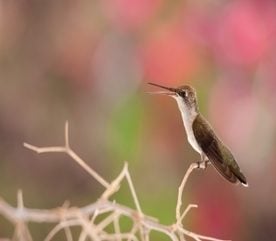How to Attract Wildlife to Your Landscape
A mere 100 years ago, the greater portion of our landscape was farmland. There were wood lots, hedgerows, and weedy areas between fields where birds and other wildlife could find the food and cover they needed to survive, says Karen Williams, owner of Flora for Fauna in Woodbine, New Jersey. She also serves as a consultant to the Cape May Stopover Project, whose long-term goal is increasing the habitat available for migrating birds.

As the land was divided up into small parcels for homes and businesses, a lot of the cover and food sources were eliminated. As a result, wildlife populations declined. Does it matter? “A healthy environment means a place where lots and lots of different animals and plants are able to survive and thrive,” says Williams. “By encouraging wildlife, we are completing an ecosystem where everything works together.”
Wildlife you Want to Attract
If the mention of wildlife calls up visions of skunks, possums, and raccoons, that’s not what Williams is talking about. These animals are attracted by garbage, not by a backyard habitat. The wildlife she is talking about means birds, butterflies, and insects.
Plant Species that Attract Wildlife
Landscaping for wildlife can include a lot of different elements, says Williams. The trick is to choose plant species not only for their beauty, but also for what they can provide. This means taking into account their merits as bloom, fruit, and seed producers. For example, perennial borders and wildflower meadows contain flowering plants that are nectar and seed sources for wildlife. Trees under-planted with shrubs that produce fruit provide food and protection.
Won’t Lots of Insects Lead to Devastation in the Garden?
“Insect populations seldom get out of control because nature tends to create a balance,” says Williams. One year, for instance, there was an outburst of Japanese beetles in her garden. She didn’t take any action, waited it out, and the next year had only a couple of beetles.
“The predatory insects tend to eat the plant-eating insects. You have to have faith in the fact that nature is always shifting and that the pendulum will swing back.”
Gardening for wildlife does mean your garden might not look like a garden catalogue. “We’ve been lulled into the belief that gardens should look perfect,” she says. In a diverse garden, “We have to learn to find what natural beauty is.”



